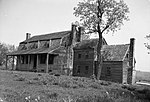Rosecroft Raceway, nicknamed the "Raceway by the Beltway" for being close to Interstate 495, is a harness racing track in Fort Washington, Maryland. It first opened in 1949 and was owned by William E. Miller, a horse trainer and breeder. Rosecroft quickly became Prince George's County's political and social center, drawing thousands of people there each racing day. In the early 1950s, average attendance was more than 7,000 per day. After Miller died in 1954, his son John owned Rosecroft until his death in 1969. Rosecroft hosted memorial stake races annually for both William and John until 1995. Following the death of John Miller, Earle Brown controlled operations until he moved to a different position in 1980; William E. Miller II took over following Brown.
Rosecroft was sold to Mark Vogel in 1987. Vogel made several mistakes that hurt the horse racing industry in Maryland. Three years later, he was arrested for possession of cocaine, and his company went into bankruptcy. Rosecroft was sold to Weisman's Colt Enterprises in 1991. In that same year, the grandstand caught fire and was reconstructed in 1993 for $3.6 million. In 1995, after losing millions, the relatives of Weisman sold Rosecroft to Cloverleaf Enterprises. In the 2000s, Cloverleaf attempted to sell Rosecroft multiple times, but due to lawsuits and politics, all the potential buyers became uninterested. Nearby states legalized casinos to help their racetracks. Money generated from the casinos was used to increase the purses and handle (daily betting turnover), and Rosecroft was unable to produce the same amount of money. After filing for bankruptcy once again, Rosecroft Raceway closed down in 2010. The next year, Penn National Gaming purchased the racetrack with the hope to make it a racino, and Rosecroft reopened in 2011.
Throughout Rosecroft's history, it has featured notable races. From 1984 to 1988, it hosted segments of the Breeders Crown. Starting in 1990 and ending in 1995, the racetrack hosted the Messenger Stakes, the second leg of the Triple Crown of Harness Racing for Pacers. Rosecroft hosted the Potomac Stakes, Maryland most successful harness race, from 1990 to 1992. Rosecroft features the Maryland Sire Stakes, which showcases the best standardbred horses in Maryland. Besides the races, Rosecroft has had famous people and horses work and race at the track. John Wagner, Maryland's all-time most winning driver, has been working at Rosecroft since 1974. Several famous people—Lyndon B. Johnson, Elizabeth Taylor, and Nancy Pelosi, among others—have visited Rosecroft. Cam's Card Shark raced at Rosecroft in 1994 and challenged the single-season record for most money won in a season by winning over $2 million, and Robust Hanover set a track record while winning the Breeders Crown in 1985.








